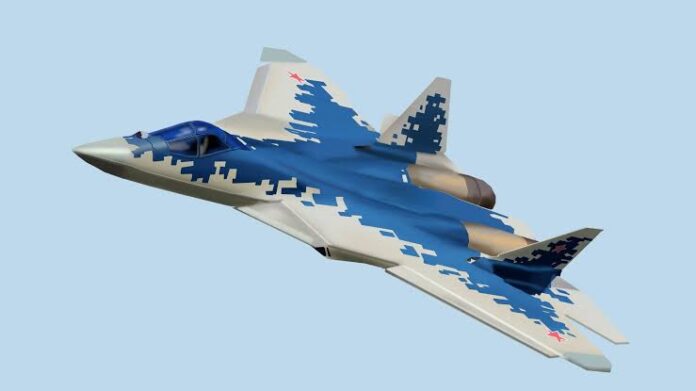The Su-57 Felon is Russia’s fifth-generation fighter jet, designed to compete with the world’s most advanced warplanes. This highly capable aircraft, developed by the Sukhoi Design Bureau, is often touted as a symbol of Russia’s military might. However, despite its cutting-edge capabilities, the Su-57 faces significant challenges, primarily due to its reliance on Western-made components. These include crucial parts like advanced radar systems and communication technology. This dependence has put the aircraft in a precarious situation, especially in the context of the ongoing conflict with Ukraine.
Russia has been cautious about deploying the Su-57 in the skies over Ukraine. The reason is simple: the aircraft is costly to maintain, and replacing it is even harder under current conditions. The war has also made it difficult for Russia to acquire the necessary components, as Western sanctions have severely limited its access to advanced technologies. The Su-57, originally designed for export and to be compatible with Western systems, has now become a burden for Moscow, as many of its key parts are no longer available. There could be atleast 20 such fighter jets available in the world right now.
US Sanctions are Devastating Russian Battlecruisers as Western Technology Access is Restricted
The Impact of Sanctions on the Su-57
When the war between Russia and Ukraine began, Western nations swiftly imposed economic, trade, and technology sanctions on Russia. These sanctions were aimed at crippling Russia’s ability to sustain its military operations by cutting off its access to critical technologies. The Su-57, like many other modern Russian military systems, is heavily reliant on foreign-made components. As a result, maintaining and keeping the Su-57 operational has become a serious challenge for Moscow.
One of the main issues is that Russia has struggled to produce the advanced systems domestically that it once imported from the West. These systems include not only radar and communication equipment but also other sensitive technologies essential for the Su-57’s performance. With Western components now unavailable, Russia is finding it difficult to keep its fleet of Su-57s combat-ready. This is especially problematic in the high-risk airspace over Ukraine, where the plane’s advanced capabilities could be crucial. However, deploying the Su-57 under these conditions would mean risking damage or loss, something Russia can ill afford given the limited number of these jets.
Crippling US Sanctions Force ERG Luxembourg’s $2 Billion Debt Shift to Yuan
Interestingly, Russia had originally planned for the Su-57 to be a major export product. The plane was not just meant to bolster the Russian Air Force but also to attract foreign buyers. By incorporating Western technologies, Russia hoped to make the fighter jet more appealing to potential customers, as these components would make maintenance easier and more cost-effective for foreign militaries. However, this reliance on Western systems has now backfired, as sanctions have made it impossible for Russia to access the components needed to maintain them.
Circumventing Sanctions with Help from Germany
Despite the sanctions, Russia has found ways to circumvent some of the restrictions imposed by the West. Reports suggest that Russian companies have managed to acquire dual-use technologies from European countries, particularly Germany. These dual-use technologies are civilian products that can also be used for military purposes, allowing Russia to keep the Su-57 operational despite the sanctions.
OFAC Sanctions Gemini Marine for Illicit Transportation of Russian and Iranian Oil
One example of this is the Siemens KLE 360 CNC machine, a German-made device that plays a crucial role in the production of the Su-57’s radar systems. According to reports, a Russian firm called Mikropribor acquired this machine from Siemens in 2022, even though sanctions were already in place. The machine is essential for producing the MPPU-50 radar, a key component that gives the Su-57 its advanced combat capabilities. Without this radar system, the jets would be far less effective in combat.
This case highlights a significant loophole in the sanctions regime: while Western governments, including Germany, have been vocal in their support for Ukraine, some companies have continued to do business with Russia. This has allowed Moscow to obtain the technologies it needs to maintain its military capabilities, including the Su-57.
Russia’s ability to acquire these dual-use technologies from Europe has helped to offset some of the impact of sanctions, but it has not solved the underlying problem. The Su-57 is still heavily dependent on foreign-made components, and without a reliable supply of these parts, the plane’s future remains uncertain. As the war in Ukraine drags on, it will become increasingly difficult for Russia to keep the Su-57 operational without risking significant losses.
The Future of the Su-57
The Su-57 Felon remains a symbol of Russia’s advanced military technology, but it is also a victim of the country’s reliance on Western-made components. Sanctions have made it difficult for Russia to maintain its fleet of these fifth-generation jets, and while Moscow has found ways to circumvent some of the restrictions, the long-term sustainability of the Su-57 is in doubt. For now, the aircraft remains a powerful but troubled weapon, caught in the crossfire of geopolitical tensions and economic sanctions.


